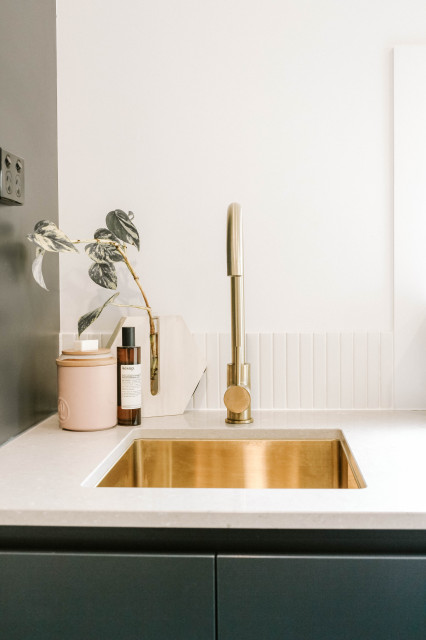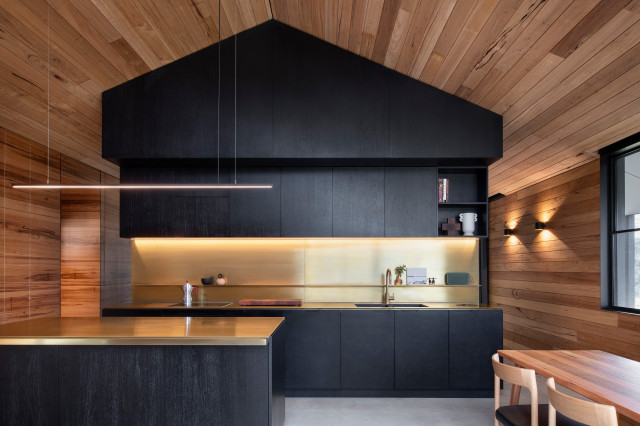If there’s one thing architects, interior experts, forecasters and leading designers agree on it’s this: our collective experience of lockdown will fundamentally alter the way we live in the future. Our recent awakening will change what we place importance on; from the materials we choose, to the design of our living spaces, who we live with, and how we want our spaces to interact with and ultimately fulfil us.
Read on for how thought leaders say the life-changing experiences of 2020 will play out in the near future. And a note that the links to further stories will give you a comprehensive overview and more insights into all the trends we see coming in the near future.
Kitchen and bathroom designers Darren Genner and Simona Castagna of leading firm Minosa expect to see the use of high-tech materials that combine antibacterial properties with scientific advances, in particular nanotechnology.
Genner sites the example of nanotechnology-enhanced laminates, which leave no trace of fingerprints. These hard-wearing laminates have thermal recovery properties that repair surface micro-scratches. In layman’s terms, he says “it remembers its form, so when you scratch it, you simply apply heat and it returns to its original state”.
Biodesign the creation of furniture and objects from living organisms, is another important way we will see advancements in product design and materials in the foreseeable future.
Where once experimentation with colour and texture in a home was primarily through paint colour and application, it is now moving onto tiles – and bricks – with incredible results.
- Tiles: The rise of zellige tiles (handmade tiles from Morocco) as well as recent collaborations between manufacturers and artists – including Mutina with artist Nathalie Du Pasquier and aforementioned Patricia Urquiola (among others) and Fornace Brioni with designer Cristina Celestino – have elevated tiles into an art form.
Artedomus Lithos Design tiles; image by Peter Clarke
“It feels like a renaissance of sorts,” says award-winning architect Emma Rees-Raaijmakers of Atelier DAU.
“[Tiles are] fun and can add an incredible amount of energy and character to a space for a relatively small investment. The key is investing in good-quality tiles. You are effectively buying a work of art for your wall or floor.”
- Bricks: Bricks are back. Not ’60s red brick or a quick and cheap building block, but beautiful bricks, used externally as pictured here, or internally. “Clients and developers are finally starting to see the value in investing in beautiful building materials for the long term,” says Rees-Raaijmakers. “In a country like the Netherlands, housing is built almost entirely of brick. Bricks bring character, texture, scale and warmth to both interiors and exteriors of buildings. Even better, reusing old bricks is a win-win.”
Let’s start with what won’t be happening. The ‘big is good’, philosophy and fundamental belief in set layouts that can’t change and grow with a family will be revisited.Rees-Raaijmakers says the future is about repurposing and reinventing (the pictured home is a great example, involving the renovation of a postwar home for modern living); building for the long term, not just for tomorrow.
“In terms of architectural trends, I like to see it more that people’s mindsets are shifting. And the way we live needs to change,” says Rees-Raaijmakers.
“Our houses (and apartments) need to be designed to be more adaptable to provide opportunity for quiet. Open-plan living has its benefits but how to optimise space within our homes is more critical than ever.
“There is an increasing necessity for creative solutions for living small. Younger generations (and clients) are seeking creative space-planning solutions for small-footprint dwellings and apartments, driven both by housing affordability, construction costs and an environmental consciousness. You only need to look to Japan as proof that living small can be elegant and beautiful.”
Castagna says they are seeing many of their clients thinking more about what needs to go into their space. “The kitchen is no longer [simply] a kitchen, it is the living room where (almost everything) happens so the space needs to be integrated with the living area. It needs to be able to do work, it needs to be clean, it needs to open up when it’s time to prepare meals, it needs to close down so we don’t see it all the time, it needs to look great as people are in here a lot. We need it for casual meals, we need it to gather around when we do get the opportunity to entertain, but most of all in needs to be for the people… the people who will live in the space together.”
This goes to the point of how designers think: how they investigate and see opportunities in each project they are given, with a view to maximising the adaptive use of that space.
With the Inquiry into the Quality of Care in Residential Aged Care Facilities in Australia revealing concerning treatment of the elderly and the enforced separation from the elderly experienced during the pandemic, there is likely to be a move to multi-generational living. This will flow through to more adaptive housing design – think non-permanent walls that are able to be shifted and multipurpose rooms and inventive ways that rooms can be opened up and shut off as needed.
Upper wall in Resene Zen, lower wall in Resene Woodland, floor in Resene Colorwood Dark Ebony timber stain.
4. Nature as saviour
Rees-Raaijmakers says designing for wellbeing – green roofs, internal courtyards and external sightlines – is growing in importance.
“Increasingly, architecture and interiors are looking for interesting ways to integrate nature throughout [a home]. Connection with nature is essential to wellbeing. When we design any space, the garden is a central part of the design-making process. The two need to work together and be seamlessly integrated.
“Biophilic design, an approach to architecture that seeks to connect building occupants more closely to nature, is very much in the conversation at the moment.”
- As is the integration of natural colours… In New Zealand, Laura Lynn Johnston, editor of Habitat by Resene, says that our future colour choices will also be informed by our emotional needs for security and calm. “More than ever, there is a desire for soothing and calming spaces in our homes, but we also need spaces that are stimulating to spend time in – much more time, perhaps, than we might be used to.”
Colour forecaster and creative director at Nexus Designs, Sonia Simpfendorfer agrees our collective brush with mortality has created a desire for things that are authentic, real, natural and that support wellbeing.
“Nature will continue to be a source of inspiration for colour, and earthy colours (yes, that does include brown) will continue to underpin many palettes, expressed as sand, stone, beige and camel, plus soft greens and warm browns.


















 Prev
Prev
If there’s one thing the pandemic has burned into our brains, it’s the importance of hygiene.As individuals we’ve embraced hand washing, sanitising and the wearing of masks.
And just as sanitary practices have become a life-saving virtue, a rise in automatic washbasins, touch-less flushing systems, and infra-red sensors in our bathrooms will meet our desire to reduce excessive contact with surfaces.
Influential Spanish architect and product designer Patricia Urquiola also believes that there will be greater demand for surface coatings that are bacteriostatic (capable of inhibiting the growth or reproduction of bacteria). Likewise, trend forecaster for London-based firm Scarlet Opus, Victoria Redshaw, believes that antimicrobial metals (which kill microbes or stops their growth) will also be in demand.
Copper and its alloys, brass and bronze, fulfil this criteria so expect to see more tapware, and kitchen and bathroom fixtures such as sinks and splashbacks, made from these materials.